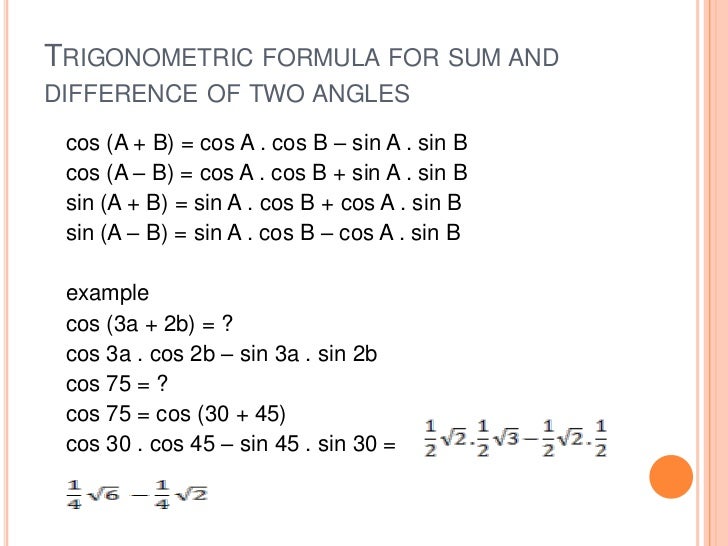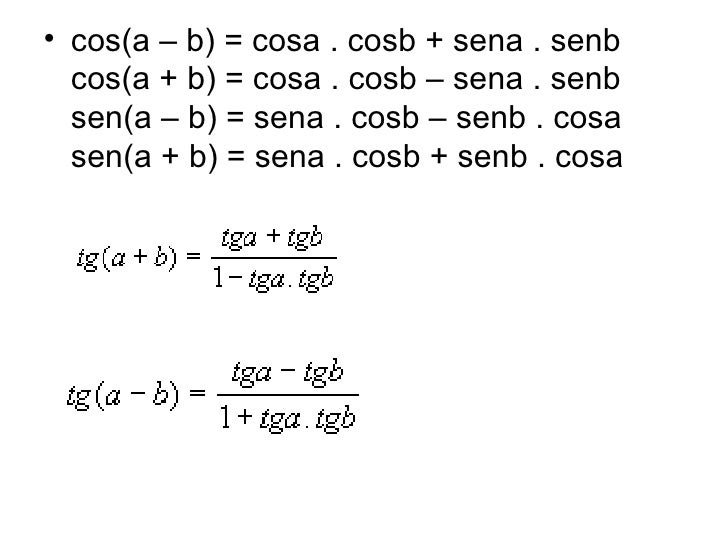
7 TRIGONOMETRY ( PRODUCT FORMULA SIN(A+B).SIN(AB),COS ALSO AND SOME IMPORTANT TRICK) YouTube
Trigonometric Identities are useful whenever trigonometric functions are involved in an expression or an equation. Trigonometric Identities are true for every value of variables occurring on both sides of an equation. Geometrically, these identities involve certain trigonometric functions (such as sine, cosine, tangent) of one or more angles.. Sine, cosine and tangent are the primary.

Cos (a + b) Formula, Proof, Examples What is Cos(a + b)?
The formula of cos (a+b)cos (a-b) is given by cos (a+b)cos (a-b) = cos 2 a -sin 2 b. In this post, we will establish the formula of cos (a+b) cos (a-b). Note that cos (a+b) cos (a-b) is a product of two cosine functions. We will use the following two formulas: cos (a+b) = cos a cos b - sin a sin b. (i) cos (a-b) = cos a cos b + sin a sin b. (ii)

Cos A B Formula TRANSFORMACIONES TRIGONOMÉTRICAS DE SUMA A PRODUCTO Y DE Formulas for
Learn to derive the formula of cos (A + B). Proof of expansion of cos(A+B). cos (A +B) is an important trigonometric identity. We all learn the expansion and.

the Cosine Rule National 5 Maths
Formula ( 1). cos ( a + b) = cos a cos b − sin a sin b ( 2). cos ( x + y) = cos x cos y − sin x sin y Introduction Let us consider that a and b are two variables, which denote two angles. The sum of two angles is written as a + b, which is actually a compound angle.

Trigonometry
The Law of Cosines (also called the Cosine Rule) says: c 2 = a 2 + b 2 − 2ab cos (C) It helps us solve some triangles. Let's see how to use it. Example: How long is side "c". ? We know angle C = 37º, and sides a = 8 and b = 11 The Law of Cosines says: c2 = a2 + b2 − 2ab cos (C) Put in the values we know: c2 = 82 + 112 − 2 × 8 × 11 × cos (37º)

Cos A Cos B Cos C Communauté MCMS
Trigonometric Identities Purplemath What is an identity? In mathematics, an "identity" is an equation which is always true, regardless of the specific value of a given variable. An identity can be "trivially" true, such as the equation x = x or an identity can be usefully true, such as the Pythagorean Theorem's a2 + b2 = c2 MathHelp.com

Understanding Cos A+B Formula
The trigonometric identity Cos A - Cos B is used to represent the difference of cosine of angles A and B, Cos A - Cos B in the product form using the compound angles (A + B) and (A - B). We will study the Cos A - Cos B formula in detail in the following sections. Cos A - Cos B Difference to Product Formula

IDENTIDADES TRIGONOMÉTRICAS PARA LA SUMA Y RESTA DE ÁNGULOS
Cosines Tangents Cotangents Pythagorean theorem Calculus Trigonometric substitution Integrals ( inverse functions) Derivatives v t e In trigonometry, trigonometric identities are equalities that involve trigonometric functions and are true for every value of the occurring variables for which both sides of the equality are defined.

Law of Cosine (Cosine Law) with Examples and Proof Teachoo
Step 1: Simplifying the expression. cos8x(1 + cos2x) c o s 8 x ( 1 + c o s 2 x) cos8x + cos8xcos2x c o s 8 x + c o s 8 x c o s 2 x. Now we still have two cos terms in multiplication, we can simplify it further by using the formula we just learned. Step 2: Applying the cos a cos b identity.

Law of Cosine (Cosine Law) with Examples and Proof Teachoo
The formula of cos (A + B) is cos A cos B - sin A sin B. Example : If sin A = 3 5 and cos B = 9 41, find the value of cos (A + B). Solution : We have, sin A = 3 5 and cos B = 9 41 ∴ cos A = 1 - s i n 2 A and sin B = 1 - c o s 2 B cos A = 1 - 9 25 = 4 5 and sin B = 1 - 81 1681 = 40 41 Now, By using above formula,

What is the Law of Cosines? (Explained in 3 Powerful Examples!)
cos^2(a + b) = cos^2(a) + cos^2(b) - 2cos(a)cos(b). Proof of Cos(a + b) Formula. The cos(a+b) formula is a mathematical expression used to determine the angle of two vectors. The formula is derived from the law of cosines, which states that the cosine of the angle between two vectors is equal to the product of their magnitudes and the sum of.

cos(A+B) YouTube
Get Started Cos (a + b) In trigonometry, cos (a + b) is one of the important trigonometric identities involving compound angle. It is one of the trigonometry formulas and is used to find the value of the cosine trigonometric function for the sum of angles. cos (a + b) is equal to cos a cos b - sin a sin b.

law of cosines Law of cosine (cosine law)
Product to Sum Formulas sin x sin y = 1/2 [cos (x-y) − cos (x+y)] cos x cos y = 1/2 [cos (x-y) + cos (x+y)] sin x cos y = 1/2[sin(x+y) + sin(x−y)] cos x sin y = 1/2[sin(x+y) - sin(x−y)] Sum to Product Formulas sin x + sin y = 2 sin [ (x+y)/2] cos [ (x-y)/2] sin x - sin y = 2 cos [ (x+y)/2] sin [ (x-y)/2]

Cos (a b) Formula, Proof, Examples What is Cos(a b)?
In trigonometry, cos (a - b) is one of the important trigonometric identities, that finds application in finding the value of the cosine trigonometric function for the difference of angles. The expansion of cos (a - b) helps in representing the cos of a compound angle in terms of trigonometric functions sine and cosine.

Trigonometry
Maths Math Formula Trigonometry Formulas Trigonometry Formulas In Trigonometry, different types of problems can be solved using trigonometry formulas. These problems may include trigonometric ratios (sin, cos, tan, sec, cosec and cot), Pythagorean identities, product identities, etc.

Cos A B Formula TRANSFORMACIONES TRIGONOMÉTRICAS DE SUMA A PRODUCTO Y DE Formulas for
Cos a Cos b is a trigonometric formula that is used in trigonometry. Cos a cos b formula is given by, cos a cos b = (1/2) [cos (a + b) + cos (a - b)].